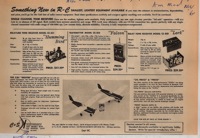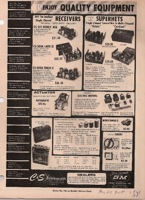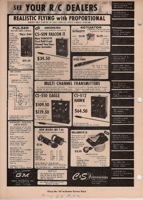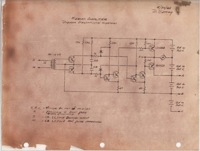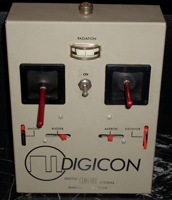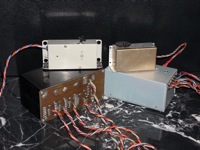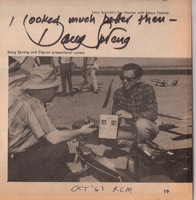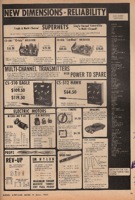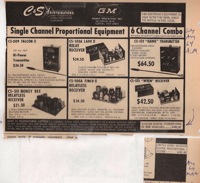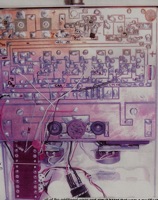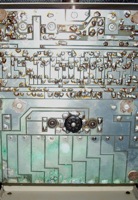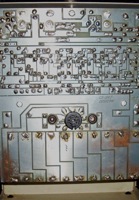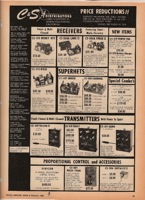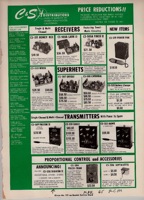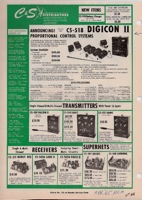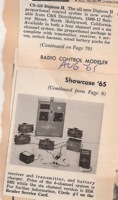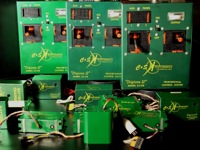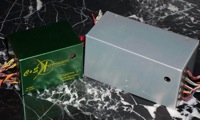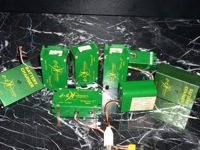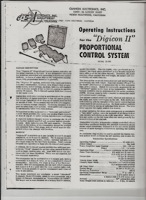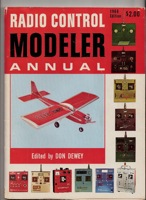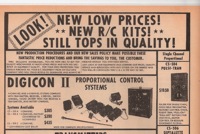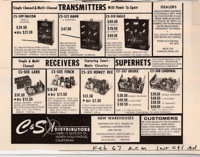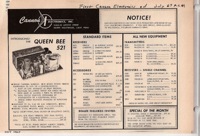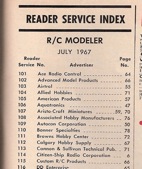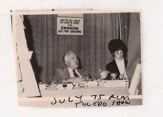Special Exhibit:
C&S ONE
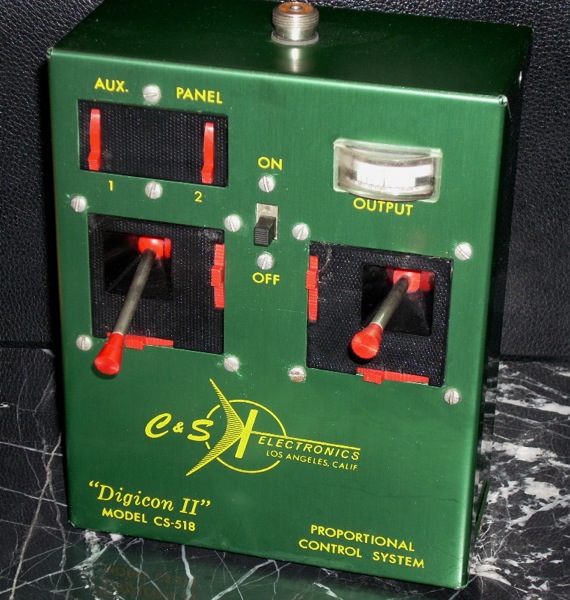
(Click on any of the images on this page to see a larger version)
This Digicon II belonged to Bill Cannon, the owner of C & S. How important is that? Bill Cannon was the number one US radio control manufacturer by at least one important criterion – Survival; his RC companies enjoyed sustained success and outlasted all others. The Digicon was special too. It was the world’s first modern digital proportional system with breakthrough circuits copied by manufacturers around the world to this day. So fasten your seatbelts. This one takes us deep into radio control history.
C & S One.
It all began in 1949. That’s when William M. Cannon, Jr. decided to leave the safety of his steady job at Lockheed and venture out into the cold, unforgiving world of self-employment. He had been a technical writer at Lockheed writing manuals on engines, airframes, radios and anything else that needed explanation. He had engineering degrees from two major colleges plus numerous courses in the Navy. He knew he was the best in the business and thought he could do better starting his own.
Along with fellow employee Crawford Sullivan, Bill Cannon formed Cannon & Sullivan Technical Publications. In this new firm they continued to write technical publications for their former employers and other clients, and they prospered. Neither of them had anything to do with remote controlled airplanes. Little did they know that almost twenty years later there would be a vibrant new hobby called “radio control” and that their firm name would mysteriously appear in the index of a magazine called Radio Control Modeler. When the name showed up on page 77 of the July 1967 edition, no one at RCM had heard of “Cannon & Sullivan Technical Publications” and no one in the hobby had any idea what it was doing in RCM. No one except Bill Cannon that is. You see, back in 1949 he would sometimes refer to “Cannon & Sullivan Technical Publications” by its nickname. C&S.
C&S.
Cannon had always enjoyed the hobby of building free flight and control line model airplanes. In 1955, he tried radio control. After numerous crashes and flyaways he decided to design his own radio control system. Radios in that day often failed mid-flight and required endless tinkering and accommodation. His goal was to increase reliability to the point where he could forget about the radio and just fly the plane.
He designed a transistorized radio control system, and it worked well. Although he had met his goal he wasn’t allowed to rest. Fellow club members wanted him to make them radios too and word spread. Pretty soon he had a little business. Although Mr. Sullivan had long ago left Cannon’s publication firm, Bill liked the established sound of “C&S” and decided to call his new business “C&S Electronics”. For years the business was a modest sideline run out of his house with hardly any advertising and no employees. Then, in 1961, he decided to go national.
He constructed several attractive prototypes in professional looking green anodized cases with yellow C&S lettering, photographed them and took out this full page ad in Model Airplane News (May, 1961):
“Honey, I Shrunk The Radios”
From this very first ad Cannon emphasized his equipment was the smallest and lightest available. As a shrewd businessman he knew he couldn’t be best at everything. He needed a niche. He bet on smallness, and the bet paid off handsomely. Over time, Cannon developed a reputation, for having the smallest and lightest equipment anywhere. As the years passed, one US manufacturer after another went out of business as competition, especially foreign competition, grew. Eventually only Cannon was left. He clung to his niche and survived.
Then, incredibly, he kept going. His company continued to design and build radio control systems, in the U.S., until 2004. Even in 2004 he wasn’t forced out of business like others. He left on his own terms, at his own timing, for his own reasons (health).
Birds And Bees
For a few months after his first advertisement he continued to have a plant in Phoenix make the equipment for him. But long distance manufacturing quickly proved unworkable and he moved production to his location in Los Angeles. In November of 1961 he ran a new ad changing the Company’s address to Los Angeles and introducing bird names for his equipment. The transmitter became “Falcon” and the receivers “Hummingbird” and “Lark”. He did this because he loved birds and they flew beautifully. He probably also felt modelers would remember and prefer names compared to mere numeric designations. Here is that ad (Nov 61’ AM):
It wasn’t long before C&S had a whole flock of birds including 6, 10 and 12 channel reed systems. He even added a smaller, lighter receiver called honeybee (no bird was small enough) and advertised the birds and the bees as seen in this two page ad (May 64’ RCM):
Note that the advertised name was changed to C&S Distributors (starting in 1963). C&S Distributors was a separate company which sold C&S Electronics radios plus an array of equipment from other manufacturers such as Tatone and GM, and sold to dealers. The range of products offered by C&S Distributors was extensive. There was just one thing missing, and it was big.
C&S had no multi proportional system. This was the golden age of proportional development; a wave of excitement and inevitability swept over the industry and all manufacturers knew they must either go proportional or perish. Like the others, Bill Cannon was furiously experimenting with various possible systems but was unable to come up with one having the performance, reliability and commercial practicality he sought. As he toiled in the lab with one frustrating attempt after another, he had no idea that the most important proportional system in the world was about to land in his lap.
Digicon
A few years earlier, just blocks away from C&S’s Saticoy Street plant in North Hollywood, another RC pioneer was experimenting. His name was Doug Spreng. Neither Spreng nor his wife had any idea he was about to become a father. The father of modern proportional control systems (one of several, to be fair).
Spreng was guided by another “father” of proportional RC, Jerry Pullen. Pullen helped him get a job at Jet Propulsion Laboratories (JPL) where the two had access to the latest transistors and technology. Jerry Pullen demonstrated his pioneering proportional system for Doug Spreng. Spreng was amazed and very impressed with Pullen’s achievement as was everyone else. But Pullen’s system (2+ channels) had limited controls and another basic problem called analog lag. This problem was well explained by RC authority Jack Albrecht in his article on Spreng’s Digicon system (Feb 03’ RCM):
“Jerry’s analog proportional system worked very well and Doug flew one for a while, but it was just too slow to react since it was based on analog tones in the low kilohertz range. The necessary low pass filtering in the tone detection circuits made the response so slow that it interfered with the natural human response time. For instance, you would ask for a little elevator stick control; it doesn’t happen right away so you ask for a little more. By that time the first amount you asked for appears, the little more you asked for when you didn’t see the result of the first bit is just too much. This results in “analog gallop” and it takes all the joy out of flying. Doug just knew the system reaction time had to be less. He figured ten times less would be needed to take human reaction time out of the loop.”
Doug Spreng developed a Pulse Width Tracking system to get rid of the delay. This enabled the response time to be lowered from hundreds to tens of milliseconds. The Bonner Digimite 8 also was digital and used millisecond pulses but the servos were analog so they were still slow to respond. Spreng’s historic breakthrough was to design a new servo amplifier, so the servos could take full advantage of millisecond digital pulses and respond instantly. His design has been used by modern proportional systems to this day. Here is his 1962 schematic for this historic concept; from our encyclopedia of radio control:
By late 1962, the system seemed ready to unveil to the public. Doug Spreng and Don Mathes (who did the RF and mechanical work) formed a company called Digital Control Systems and named their system the “Digicon”. The new product was announced in the December 1962 edition of American Modeler. The receiver was huge, housed in a black plastic case and had no less than six decks. One was the RF receiver the second the logic and the last 4 were servo amplifiers. The amplifiers were built into the receiver to enable use of standard size, light weight servos like the Bonner Duramite and later, Don Steeb servos.
The announcement proved premature. Performance and production problems plagued the new system and it was almost a year before it could be truly introduced to the public. The second new product announcement was in the November/December 1963 issue of American Modeler and the November issue of RCM. A review of the system was presented in the February 1964 issue of RCM:
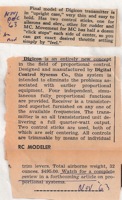 | 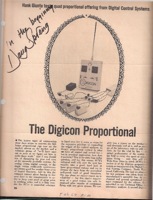 | 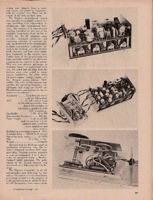 | 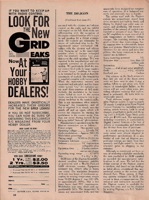 |
By now the receiver was a more traditional two decks with aluminum case, but it was still huge since it still carried the servo amplifiers onboard. The servos used were now Don Steeb models which RCM couldn’t help but mention were “one of the finest servo units we have seen to date”. The transmitter evolved through three generations (see below) but its exterior always looked like this:
Here are the two generations of receivers and servos:
And here is a picture of Doug Spreng promoting the system (October 63” RCM):
Here is the November 63 product announcement in RCM, and the original glossy studio photograph used to make the announcement:
The Digicon was snatched up by top contest flyers like RC legend Jerry Nelson. These were perfectionists, always looking for in edge in the competition. They had to have the very best and didn’t mind paying for it. Putting a new system in the hands of champion pilots was every manufacturer’s dream since contest victories generated great publicity and lead to mass sales. In Digicon’s case this practice quickly killed the company.
At first, flyers couldn’t stop raving about how great the system was, especially the speed and instantaneous response of the servos. But then they discovered that neutrals would drift during flight whenever signal strength weakened (e.g. at distance).
This problem wouldn’t cause crashes it would merely put the ship out of trim from time to time during a flight. To sport flyers the problem would be fairly minor, but for contest pilots it was, and should have been, completely unacceptable. F&M’s Frank Hoover was kind enough to propose a fix in late 1963. By adding his “spike off” scheme the problems disappeared. Spreng and Mathes recalled all existing systems and added the “spike off” for free. This may explain the second new product announcements for Digicon in November 1963.
But it was too late. The damage to their reputation was not so easily repaired and they lost too much time and money in their effort to cure the neutral drift deficiency. Production got further and further behind schedule, orders were revoked and finances crumbled. They now had the world’s best radio control system, fully functional with all the bugs out, but were unable to do anything with it. Fate delivered the Digicon to Bill Cannon.
C&S Takes Over
It’s not surprising he stepped in to take over. Bill Cannon was their colleague, their North Hollywood neighbor and most importantly, he had a successful company with the resources to rescue Digicon and take it to the next level. In the June 1964 C&S ad, just 4 months after RCM’s review of the Spreng/Mathes Digicon, there was a tantalizing clue if you looked closely at the lower right hand corner of the second page (June 64’ MAN):
The next month it was announced that “C&S Electronics has bought out the Digicon Quad Proportional Control System and by now should be in production…”(July 64’ MAN). We do not know how much C&S paid for Digicon. We do know that Doug Spreng never patented his invention and never received royalties from the many manufacturers who used it over the years or those who continue to use it today.
C&S then ran this ad announcing Digicon sales (Jul/Aug 64’ AM):
This was followed by a similar ad in the August issue of Model Airplane News with the notation “Limited Offer – Digital Digicon Proportional System -- $495”. C&S sold the second and third generation Digicon systems and serviced the first. Receiver and servo generations are discussed above. All generations of transmitters were identical externally including the words “Burbank, California” on the front (not C&S’s North Hollywood address).
The first generation looked like this on the inside. The small circuit board at the bottom left was installed by RC expert Darrell Yonker for Spreng & Mathes in all recalled Digicon’s to incorporate the Hoover Spike Off:
The second generation of Digicon transmitters looked like this. The longer, redesigned circuit board encompassed the Spike Off plus, oddly, a row of ten pen cell Nicads individually soldered to the board in lieu of a battery pack. These boards carried no identification (like generation one boards) and may have been made before the company changed hands. Spreng doubts this and doesn’t believe Mathes would ever solder batteries to a transmitter. Built-in batteries were not a C&S practice either so this feature remains a mystery.
The third generation of Digicon transmitters had this same board (with batteries) but it was clearly identified as a C&S product and carried the C&S model number 516. Perhaps C&S had additional cases and other components and did a limited production run of the boards to enable completion and sale of the transmitters. Production of additional components may have also been necessary to support additional Digicon sales during the unanticipated delay period before the Digicon II was ready:
Digicon II
The next C&S ad in September 1964 curiously made no mention of the Digicon or any proportional system. We suspect this was because at the time ad copy was submitted (July?) C&S believed their Digicon II was imminent. In the September/October edition of American Modeler the C&S ad announced that the new Digicon II was now available for $495. Oops! This was gun jumping. The new system would not be ready for many more months and the price would not be $495.
From October of 1964 through February of 1965 C&S returned to advertising the original Digicon for $495. None of these ads had any pictures or details and the largest looked like this (Feb 65’ MAN):
In March 1965 this lower left hand block of the standard C&S ad changed to announce the Digicon II. Its nomenclature was revealed (CS-518) and that it would be available in both 4 and 6 channel versions, but there was still no picture or price (Mar 65’ RCM):
One month later the sleek Digicon II was revealed to the RC world for the first time (April 65’ RCM):
Note how hard it is to see the details in this picture. All C&S ads had this poor photographic quality for Digicon II images and this is one possible explanation why this marvelous system appears to have sold in surprisingly low numbers.
The price for the complete system was fixed at $550. To put the Digicon II debut in context, this same issue of RCM also reviewed the Bonner Digimite for $615 and advertised the analog Sampey 500 (still not priced), Kraft 12 channel reeds for $209, Citizenship Analog proportional for $249, Controlaire 6 channel reeds for $89, Orbit analog proportional for $595 and a teaser ad stating a new system called Micro Avionics would soon emerge.
For some reason, the new product announcement did not appear until four months later (Aug 65’ RCM):
Here are pictures of actual 4 and 6 channel Digicon II’s from our museum:
The 4 channel version could be converted to 6 by C&S for a mere $56. The advertisement said this required a special convertible 4 channel system which cost $5 more, but all four channel transmitters we have seen are inherently convertible since they use a 6 channel PC board and simply leave 2 sections for possible future addition of channels 5 and 6. Here’s how one looks:
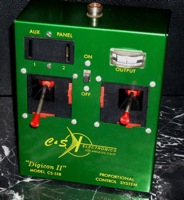 | 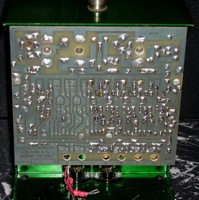 |
Perhaps C&S planned or actually produced permanent 4 channel transmitters with a 4 channel layout and/or no opening for future auxiliary controls in the upper left hand corner. More likely, the special “convertible” 4 channel system came with a 6 channel receiver case with 2 sections empty for future upgrade. The “pure”, nonconvertible 4 channel receiver had 2 advantages besides lower price. It was lighter (4.9 ounces vs. 5.3 ounces for a 4 channel in a 6 channel case) and smaller. However, it could never be upgraded since there was simply no room inside for expansion. Here, for comparison, are the pure 4 channel, the convertible 4 channel and the 6 channel, jackets off:
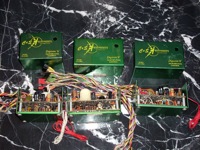 |  |
The Digicon II receiver was much smaller and lighter than its predecessor. This was primarily due to moving the servo amplifiers out of the receiver and into the servos. Component size was also reduced in some respects. The result: The Digicon receiver weight of 11.1 ounces was reduced to 4.9 ounces in Digicon II (comparing 4 channel to 4 channel). The dramatic difference is obvious in this picture of the 2, side by side:
But the weight wasn’t merely shifted to the servos. The system used plastic-cased Bonner Digimite servos with C&S amplifiers. They weighed 3.4 ounces compared to the original Digicon (Bonner or Steeb) servo weight of 2.7 ounces. Thus, the 4 channel Digicon II lost 6.2 ounces in its receiver and only gained back 2.8 ounces in the servos for a net improvement of 3.4 ounces. The overall onboard weight dropped to 23 ounces from 32 on the Digicon. Here is an example of the Digicon II servos, battery pack and charger:
Here are the operating instructions (first page only), which tend to support our theory that the convertible 4 channel system differed only in having a receiver with a 6 channel case and board:
Note that both the instructions and the advertisement proclaim that the Digicon II eliminates problems of earlier proportional systems. The ad mentions twice that the servo neutrals don’t drift – the particular problem which plagued the Digicon.
In September 1965 RCM ran a product review on the Digicon II. Surprisingly, the review never mentioned its historic predecessor the Digicon, not even in the extensive technical discussion (normally written by the manufacturer). If C&S sought a clean break for its improved system from the troubles of the Digicon, they would have chosen a different name. Another oddity is the system being reviewed in a boat rather than an airplane. RCM felt the need to explain this (page 68) no doubt to avoid any suggestion Digicon II was merely a boat radio. Still, this selection probably didn’t help C&S win its target market.
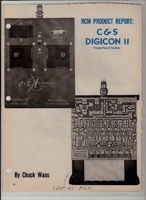 | 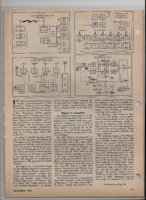 | 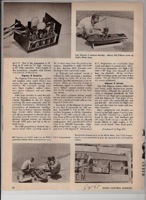 | 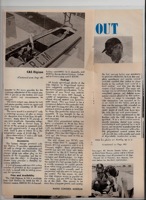 |
The 1966 Annual edition of RCM showcased on its cover the incredible (and unsustainable) number of American proportional systems then available (actually only some of them). Digicon II was among them:
The Earth Shakes
Five months after the RCM review, C&S introduced this new ad, substantially reducing the price of the Digicon II (Feb 66 MAN):
This ad was no doubt a response to slowing sales and increasingly formidable competition. February 1966 also happened to be when Proportional Control Systems (PCS) introduced its digital system for $299. This shocked the RC manufacturing world like a meteor hitting earth in the age of the dinosaurs. PCS was headed by industry stars Jerry Pullen and Cliff Weirick to avoid the appearance of low price = low quality. Actually, its quality was just fine, Kraft fine in fact, since it was secretly a division of industry leader Kraft Systems. The emergence of PCS changed everything.
Note how the new C&S ad also stressed the importance of buying from an old line company that would still be around to service the equipment in the future. Other companies made the same pitch but no one lived up to it like Bill Cannon. He was the horse to bet on that would end up going the distance. Cannon’s companies were still around long after PCS and even Kraft had perished. This ad was a great example of truth in advertising.
The ad continued to run through July 1966 and then the Digicon II left the scene. C&S placed no further ads in Model Airplane News of any kind but continued to run smaller ads in RCM for single channel and reeds only. Here’s the last in this series – the last ad for C&S (Feb 67’ RCM):
Another Metamorphosis
Big changes were in the works. In July of 1967 it was announced that Cannon Electronics was taking over C&S Electronics’ business. Here’s the first ad for Cannon Electronics. Note the initial use of the same logo and graphics as C&S, for continuity (July 67’ RCM):
The curious thing was that this ad was not placed and paid for by Cannon Electronics or by C&S. This milestone ad, heralding the birth of Cannon Electronics and marking the retirement of the venerable C&S, was put in RCM by a company with no connection to radio control – Cannon & Sullivan Technical Publications. Here’s the advertisers index from that issue (July 67’ RCM):
For reasons we may never know, Bill Cannon went “back to the future” to launch his new company, all the way back to his first business in 1949.
Cannon Electronics grew and prospered. It expanded its line to include many state-of-the-art proportional systems, high end and budget. It was succeeded in turn by two companies – Cannon R/C Systems and his wife’s company, Charlie’s R/C Goodies (his wife Charla Cannon, was called “Charlie” by friends). Here’s is a picture of both Cannons at an industry trade show (Jul 75’ RCM):
The Cannon companies succeeded year after year with a wide array of radio control systems ranging from world class miniatures to budget class sport systems. Cannon’s micro sized systems, in particular, set the industry standard for smallness and lightness, an increasingly important category, and left other manufacturers scrambling to catch up.
Bill Cannon planned to autograph his radios before sending them to us. By the time of shipment however, has health had declined further. His wife tried for three days to help him do this. But it was too late. Bill Cannon was unable to autograph our radios, but he left his signature on the entire industry. And he earned a special place in the history of radio control.




